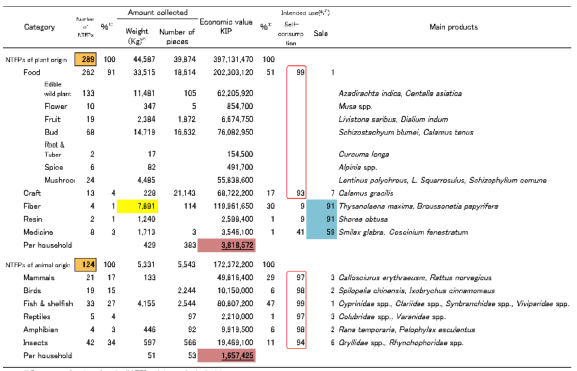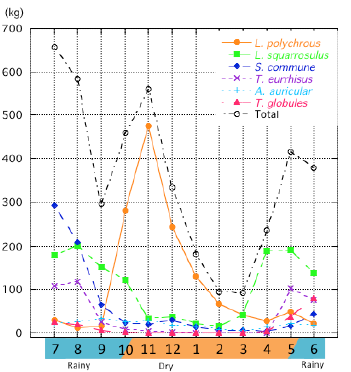Economic benefits of various non-timber forestry products to Lao PDR’s farm economy
Description
Agriculture in Laos is primarily rain-dependent due to its tropical monsoon climate. Farmlands are often subjected to droughts and floods, rendering crop production unstable. Therefore, in addition to rice cultivation, Laotian farmers collect non-timber forestry products (NTFPs) in mountainous areas, thus providing a safety net to local residents in terms of livelihood support. To understand the actual utilization of NTFPs and its contribution to rural household economies, a study was conducted on all 140 households (104 valid responses) in a farming village in the northwestern part of Vientiane Province from July 2012 through June 2013, recording each day the types and quantities of NTFPs collected as well as their intended uses. To determine the economic values, a price table was created, with each NTFP's trade price multiplied by its trade value and then converted to a monetary amount.
Over 400 diverse types of NTFPs, including 289 plant-type products (such as mushrooms) in addition to 124 animal-type products, were utilized. Excluding the types of NTFPs categorized as textiles, resins, and medicines, over 90 percent of NTFPs were used by the collecting households and mostly consumed as food. Out of 24 mushroom-type NTFPs, which are easily influenced by the forest environment, nine types accounted for 90% of collected amounts. Of these, five types are collected during rainy season, whereas one type, Lentinus polychrous (Lao name: Hed bot), is collected during dry season (Fig. 1). Mushrooms are, therefore, valuable sources of food that are collected throughout the year.
NTFPs categorized as textiles, resins, and medicines were collected for sale, and of these, approximately eight tons (dry weight) of textiles were collected (Fig. 1). The majority of these NTFPs were summer cypress, from which flower clusters are collected to make products such as brooms. Summer cypress appears in fallow land after slashing and burning and can be collected in great quantity for the first three years. It is also a valuable source of income between periods of farming.
The economic value was estimated at 5,480,000 kip (broken down into 3,820,000 kip from plant types and 1,660,000 kip from animal types) (Fig. 1). This equates to approximately 2.4 tons of glutinous rice, enough to feed 9.6 people (at 250 kg/person/year) and contributing greatly to the rural economy.
This study is important towards understanding the subsistence strategies of area residents in Laos over a full year. It can also be used as a basis for implementing safeguards, including the protection of indigenous peoples/ area residents and the maintenance of species diversity, by institutions that implement rural development programs and forest preservation programs such as participatory forest management. Lastly, it provides concrete data on NTFPs, as identified in forestry strategies by Laotian government organizations such as the Agriculture and Forestry Office and the Ministry of Natural Resources and Environment.
Figure, table
-
Table 1. Number of NTFPs, amount, economic value, purpose of collection, and main products based on the attributes of NTFPs collected
-
Fig. 1. Monthly collection for each type of mushroom
- Affiliation
-
Japan International Research Center for Agricultural Sciences Forestry Division
Japan International Research Center for Agricultural Sciences Rural Development Division
Japan International Research Center for Agricultural Sciences Social Sciences Division
- Classification
-
Technical
- Research project
- Program name
- Term of research
-
FY 2014 (FY 2011-FY 2015)
- Responsible researcher
-
Kimura Kenichiro ( Rural Development Division )
Yoneda Reiji ( Forestry Division )
KAKEN Researcher No.: 00435588Kobayashi Shintaro ( Social Sciences Division )
Xayalath Singkone ( Forestry Research Centre, National Agricultural and Forestry Research Institute )
Khamphumi Bounpasakxay ( Forestry Research Centre, National Agricultural and Forestry Research Institute )
Manivong Phonesavanh ( Ministry of Natural Resources and Environment, Lao PDR )
- ほか
- Publication, etc.
-
Kimura, et al. (2014) Paper on Environmantal Information Science, 28, 55-58.
Kimura, et al. (2014) Kanto Jounal of Forest Research, 65(2),225-228.
Kimura, et al. (2015) Journal of Japan Disaster Food Sosiety, 2(1), 45-48
- Japanese PDF
-
2014_C01_A3_ja.pdf344.86 KB
2014_C01_A4_ja.pdf448.27 KB
- English PDF
-
2014_C01_A3_en.pdf271.78 KB
2014_C01_A4_en.pdf327.77 KB
- Poster PDF
-
2014_C01_poster.pdf371.68 KB


